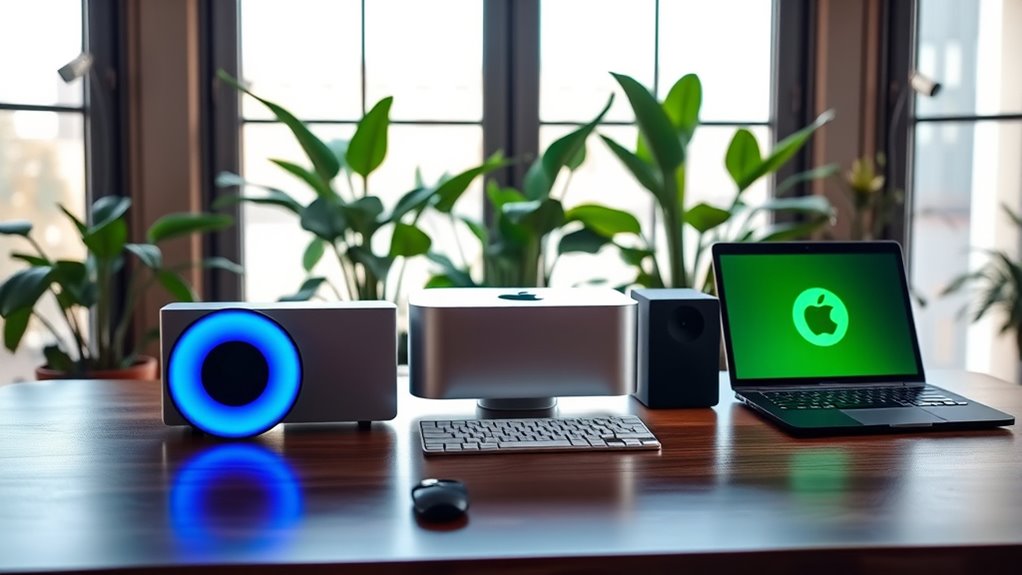If you’re looking to power up your home studio in 2025, I recommend the Mac mini with the M4 Pro chip and 24GB of memory for demanding tasks, the standard M4 with 24GB RAM for versatility, or the M4 with 256GB SSD and 16GB RAM for lighter workloads. These models offer compactness, strong performance, and excellent connectivity. Keep exploring to find out which one suits your creative space best.
Key Takeaways
- The Mac Mini with M4 Pro offers high-end performance for demanding audio and video editing tasks.
- M4 and M4 Pro models provide versatile connectivity options, ideal for connecting studio peripherals.
- Compact design fits seamlessly into home studios, saving space while delivering powerful hardware.
- Seamless integration with Apple ecosystem enhances workflow efficiency with features like AirDrop and device syncing.
- Available storage options (256GB or 512GB SSD) support various project sizes and data management needs.
Apple Mac mini Desktop Computer with M4 Pro Chip and 24GB Memory

If you’re looking for a compact yet powerful option for your home studio, the Apple Mac mini with the M4 Pro chip and 24GB of memory is an excellent choice. Its small five-by-five-inch design packs a punch with a 12-core CPU and 16-core GPU, handling demanding tasks effortlessly. The 24GB of unified memory ensures smooth multitasking, while the 512GB SSD guarantees fast data access. Equipped with Thunderbolt, HDMI, and Gigabit Ethernet ports, it offers versatile connectivity. Built around Apple silicon, it optimizes app performance and seamlessly integrates with your Apple devices, making it a versatile, high-performance hub for creative work.
Best For: creative professionals and home studio users seeking a compact, high-performance desktop with seamless Apple ecosystem integration.
Pros:
- Compact five-by-five-inch design that fits easily in any workspace
- Powerful M4 Pro chip with 12-core CPU and 16-core GPU for demanding tasks
- 24GB unified memory and 512GB SSD enable smooth multitasking and fast data access
Cons:
- Limited upgrade options due to integrated hardware design
- May be more expensive compared to other mini PCs with similar specs
- Lacks traditional expansion ports, which could limit future connectivity options
Apple Mac mini Desktop Computer with M4 Chip and 24GB Memory

The Apple Mac mini with M4 chip and 24GB of memory stands out as an ideal choice for home studio enthusiasts who need powerful performance in a compact form. Its small footprint—just 5×5 inches—fits easily next to monitors or in tight spaces. Powered by the M4 chip with a 10-core CPU and GPU, it delivers stunning speed and responsiveness for music production, editing, and creative tasks. With 24GB of unified memory and a 512GB SSD, it handles demanding apps smoothly. Connectivity options like Thunderbolt, HDMI, and USB-C ensure seamless integration with other gear. This Mac mini combines portability and power, making it perfect for a versatile home studio setup.
Best For: home studio enthusiasts and creative professionals seeking a compact yet powerful desktop for music production, editing, and creative tasks.
Pros:
- Compact size fits easily in tight spaces and next to monitors
- Powerful M4 chip with 10-core CPU and GPU for fast, responsive performance
- Ample 24GB unified memory and 512GB SSD for smooth multitasking and storage
Cons:
- Limited ports at the back may require additional adapters for extensive connectivity
- No dedicated graphics card, which might impact high-end gaming or specialized graphics tasks
- Higher price point compared to some other compact desktop options
Apple Mac mini Desktop Computer with M4 Chip (256GB SSD, 16GB RAM)

For home studio enthusiasts seeking a powerful yet compact workstation, the Apple Mac mini with M4 chip stands out thanks to its impressive performance capabilities. Its 10-core CPU and GPU deliver smooth handling of audio production, editing, and multitasking. The 16GB unified memory guarantees quick response times, while the 256GB SSD provides fast storage for your projects. Its small five-by-five-inch design fits easily into any workspace, with front and back ports—including Thunderbolt, HDMI, USB-C, and Ethernet—for versatile connectivity. Powered by Apple silicon, it offers seamless integration with other Apple devices, making it an ideal, space-efficient choice for serious creators.
Best For: home studio enthusiasts and creative professionals seeking a compact, high-performance workstation for audio production, editing, and multitasking within the Apple ecosystem.
Pros:
- Exceptional performance with a 10-core CPU and GPU powered by the M4 chip for smooth multitasking and editing.
- Compact five-by-five-inch design that fits easily into any workspace or studio setup.
- Seamless integration with other Apple devices and features like iPhone Mirroring and messaging, enhancing workflow and productivity.
Cons:
- Limited to 256GB SSD storage, which may require external drives for large projects.
- Higher price point compared to traditional mini PCs with similar specs.
- Limited upgradeability due to the integrated Apple silicon architecture.
Factors to Consider When Choosing a Mac Mini for Home Studio Workstations

When choosing a Mac Mini for your home studio, I consider factors like processing power, memory, and storage to guarantee smooth workflow. Connectivity options are also key for connecting audio interfaces and peripherals, while size and portability might matter depending on your space. By focusing on these points, you can pick the right model to meet your specific studio needs.
Processing Power Needs
Choosing the right Mac mini for your home studio hinges largely on its processing power, as this determines how smoothly your digital audio workstations, video editing, and music production run. Adequate CPU cores and speed are essential for handling real-time audio processing, complex video rendering, and running multiple demanding applications simultaneously. If your projects are intensive, a Mac mini with an M4 Pro chip featuring a 12-core CPU might be necessary to keep everything flowing seamlessly. For lighter tasks, a model with an M4 or M4 chip with a 10-core CPU can offer a good balance of performance and cost. Also, consider future needs—opting for a more powerful processor now can help you stay ahead as software and plugin demands evolve.
Memory Capacity Importance
Adequate memory capacity is essential for ensuring smooth multitasking and seamless operation of multiple audio, video, and editing applications on your home studio Mac mini. With more RAM, you can run resource-heavy plugins and virtual instruments without slowdown, which is crucial for music production and editing. Larger memory reduces the need for system caching and swapping, boosting overall workflow efficiency. It also minimizes the risk of crashes or slowdowns during intensive project sessions, maintaining reliability when it matters most. Additionally, upgrading to higher memory configurations future-proofs your setup, allowing you to handle larger files and more demanding software updates over time. In a home studio environment, having sufficient RAM directly translates to smoother, more efficient creative sessions, making it a vital factor in your decision.
Storage Requirements
Selecting the right storage capacity for your Mac mini is essential to maintaining a smooth workflow in your home studio. You should consider the size of your audio, video, and project files to avoid constant data transfers that can slow you down. I recommend at least 512GB of SSD storage if you work with large media files or multiple projects at once, ensuring you won’t run out of space quickly. It’s also smart to evaluate if external drives are needed for additional storage now or in the future. Faster SSDs can markedly boost data access speeds, improving your efficiency. Finally, balance your storage needs with your budget—opt for a capacity that provides enough space without overspending on unused storage.
Connectivity Options
Your Mac mini’s connectivity options play a key role in creating an efficient home studio setup. Multiple Thunderbolt ports are essential for high-speed data transfer and connecting external audio interfaces or MIDI controllers. HDMI ports allow direct connection to external monitors or audio equipment, streamlining your workspace. A Gigabit Ethernet port ensures reliable wired internet, which is vital for streaming, cloud-based work, or large file transfers. Front-facing USB-C ports provide quick access for peripherals like external drives, microphones, or compact audio interfaces. Additionally, a headphone jack allows for direct monitoring without extra adapters, reducing latency and improving workflow. Guaranteeing these connectivity options are available and sufficient will help you create a seamless, professional-grade home studio environment that supports all your creative needs.
Size and Portability
Since space can be a limiting factor in home studios, the size and portability of a Mac mini become essential considerations. Its compact dimensions—about 5×5 inches—make it easy to fit into tight or cluttered spaces, freeing up valuable desk real estate. The lightweight design allows for effortless movement around your workspace, giving you flexibility to reconfigure your setup as needed. This small footprint helps conserve room for other critical equipment like audio interfaces, monitors, and controllers. Despite its size, the Mac mini packs powerful hardware, striking a balance between portability and performance. Its minimalistic, sleek design also ensures it integrates seamlessly into any home studio aesthetic, without overwhelming the space or feeling intrusive.
Ecosystem Compatibility
Ecosystem compatibility plays a essential role in ensuring your home studio runs smoothly, especially when integrating a Mac mini into an existing setup. Seamless file sharing, device mirroring, and messaging are much easier when all your devices—Mac, iPhone, and iPad—work together effortlessly. Ecosystem integration allows you to sync settings, preferences, and workflows across devices, saving time and reducing frustration. Using a Mac mini with macOS optimized for Apple silicon ensures apps perform at their best, which is indispensable for creative and audio production tasks. Compatibility with popular software like Adobe Creative Cloud and Microsoft 365 further boosts productivity. Features like AirDrop and Continuity streamline data transfer and task continuity, making your home studio more efficient and less cluttered.
Frequently Asked Questions
How Does the Mac Mini M4 Compare to Other Apple Silicon Options?
The Mac Mini M4 outperforms other Apple Silicon options with its faster CPU and GPU, making it ideal for demanding creative tasks. It offers improved efficiency, better multitasking, and enhanced graphics, all in a compact design. I find it a solid choice for a home studio, especially if you need powerful processing without sacrificing space. Compared to previous models, it’s a noticeable upgrade in speed and capabilities.
Can the Mac Mini Handle Multiple Audio Plugins Simultaneously?
Imagine you’re in 1995, and yes, your Mac Mini can handle multiple audio plugins simultaneously. Today, with the M4 chip, I can run dozens of plugins smoothly thanks to its powerful CPU and ample RAM. It’s designed for multitasking, so I don’t worry about lag or crashes. Whether I’m mixing tracks or layering sounds, the Mac Mini keeps up, making it a reliable choice for home studio work.
What Are the Best Peripherals to Complement These Mac Minis?
The best peripherals to complement these Mac Minis include a reliable audio interface, high-quality studio monitors, a MIDI keyboard, and a good pair of headphones. I also recommend a sturdy external drive for backups and a MIDI controller for more precise input. These peripherals enhance your workflow, provide cleaner sound, and guarantee you have all the tools needed for a professional home studio setup.
Is Upgrading RAM or Storage Possible After Purchase?
Have you ever wondered if you can upgrade your Mac Mini after buying it? Yes, you can upgrade the RAM on some models, but it’s not always straightforward, and storage upgrades might require external solutions or professional help. I recommend choosing the right specifications at purchase because upgrades can be limited or costly later. Planning ahead guarantees your studio remains powerful without surprises down the line.
How Future-Proof Are These Mac Minis for Evolving Music Software?
I believe these Mac Minis are quite future-proof for evolving music software. Apple’s hardware updates tend to be progressive, and models with higher specs will handle future demands better. While I wish I could upgrade RAM later, I’ve found that choosing a model with ample RAM and storage upfront really helps. Overall, I feel confident they’ll keep up with software advancements for years, making them a solid choice for my studio.
Conclusion
Just like Da Vinci’s studio, your home setup can be a hub of creativity with the right Mac mini. Whether you choose the power of the M4 Pro or the versatility of the M4, these machines are your canvas. Remember, the right tool doesn’t just match your needs; it inspires your best work. So, pick the one that speaks to your passion, and turn your home studio into a masterpiece.









